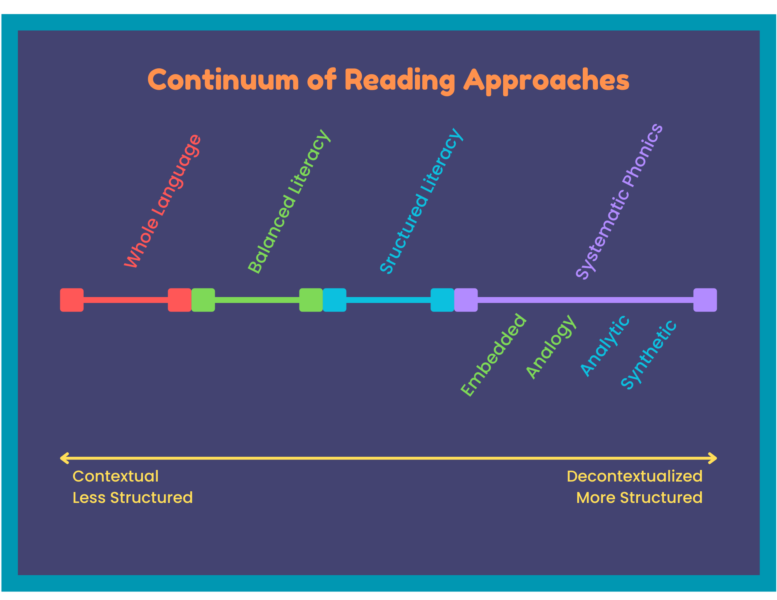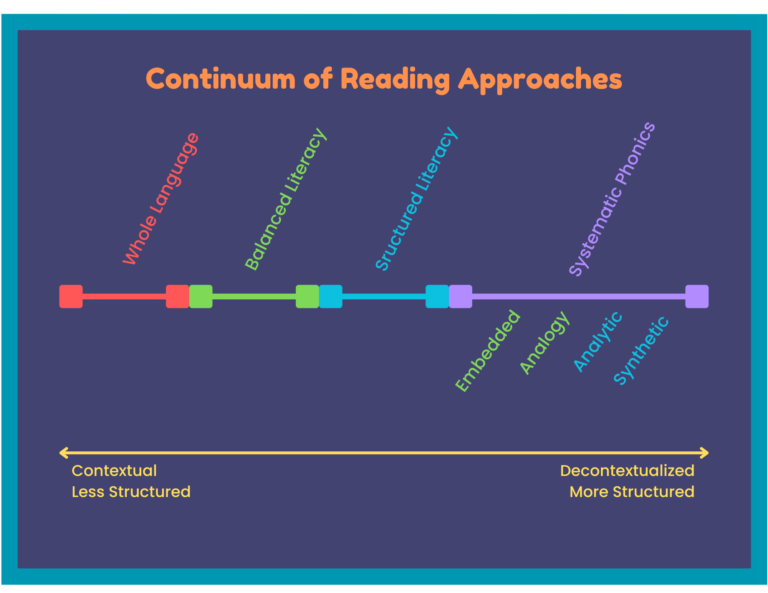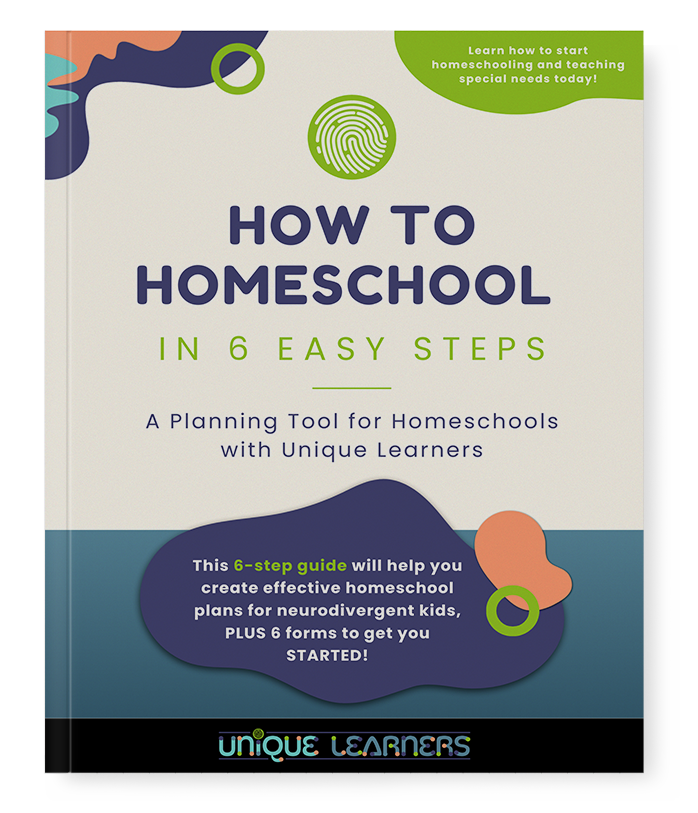A debate has consisted for about several hundred years about the best way to teach children to read. The approaches vary based on how researchers and teachers believe children are able to integrate spoken language to create meaning of written words. There will always be a debate about how children learn to read, but for kids with dyslexia, autism, or any other type of neurodivergence, the decision about teaching methods becomes much more difficult. In fact, I could even say that teaching reading to a child with a reading disability IS rocket science.
The approaches to teaching reading fall on a continuum from top-down reading to bottom-up reading. Let’s explore some popular reading programs along this continuum:

Whole Language
Whole Language is the most top-down reading approach. Whole language programs emphasize meaning of the text when reading. Beginning readers are frequently taught high frequency words or sight words and practiced within a story’s context. Repetitious text is presented to help students memorize whole words and sentences. Mainly, the focus is on developing vocabulary, fluency, and comprehension through exposure to authentic literature. Whole Language is the least structured or systematic, yet it is the approach that most emphasizes the beauty of language in literature.
In the homeschool world, a literature-based approach is the equivalent. Often homeschool literature programs use, “living books” or classics that have vivid vocabulary and quality plots.
Pros
- Students can be exposed to quality literature at their oral language level, encouraging higher level vocabulary and comprehension skills.
- Students typically have more choices in reading materials.
- Living books are engaging and rich in literary elements and devices.
Cons
- Beginning readers with symbolic processing issues or reading disabilities tend to memorize text from hearing the teacher or a peer read it aloud and pretend they are reading.
- Readers tend to rely on picture and context clues, which can easily result in guessing unknown words.
- Ultimately, vocabulary is limited to words heard or learned as whole words rather than having a tool to decode unknown words.
Balanced Literacy
Balanced Literacy emerged from the outcry of a pure whole language approach. Balanced Literacy programs combine elements of both whole language approaches and embedded phonics. The aim of Balanced Literacy is to provide a balanced approach to reading instruction by integrating phonics, vocabulary, fluency, and comprehension. Embedded phonics means that rather than systematic phonics, rules are taught as they are encountered during the reading process.
Pros
- Students can be exposed to quality literature at their oral language level, encouraging higher level vocabulary and comprehension skills.
- Some students will benefit from an emphasis on high frequency sight words, which can often be broken into sound units alongside of the embedded phonics.
- Leveled Readers can provide some vocabulary control to help young and slower learners to experience success with sight words.
- Students are exposed to some of the phonetic decoding and spelling rules that help students be aware of the the structure of language.
Cons
- Students with reading disabilities, who are given leveled readers, may struggle and become frustrated with the typical heavy emphasis on sight words.
- The quality of instruction depends heavily on the knowledge and skill of the teacher to explicitly draw out phonics rules.
- The teacher must have an intentional lesson routine to maintain a balanced approach
Structured Literacy
Structured Literacy programs are another attempt to moderate the two ends of the reading continuum. Structured Literacy has a strong emphasis on direct, explicit phonics instruction. Although systematic phonics is the cornerstone of Structured Literacy, the balance is maintained with lessons that use decodable text to develop fluency and comprehension. Additional reading skills emphasize language structure, phonemic awareness, decoding unknown words, rapid word naming, and spelling. Structured Literacy programs are based on dyslexia research.
Pros
- Structured Literacy programs are based on the systematic presentation of phonics rules, which tend to be effective for all students, including those with reading disabilities.
- Decoding skills give students the tools to sound our unfamiliar words rather than rely on memorizing whole sight words.
- Fluency building and comprehension are embedded into Structured Literacy lessons.
Cons
- The quality of instruction and motivation of students are heavily dependent on teacher knowledge and skill of using multisensory instruction.
- Robust literature is difficult to find for beginning readers, so the teacher must be intentional about integrating read aloud literature until a student has progressed with highly controlled decodable readers. This can result in creative strategies to motivate older students working at lower levels.
- Some students with more severe learning disabilities have difficulty retaining multiple phonics rules, so maintaining a balance of reading skills to maximize strengths while remediating weaknesses.
Systematic Phonics
Phonics programs focus on teaching letter sounds and rulesof the structure of the English language through explicit instruction. Phonics programs help children develop decoding skills and the ability to sound out words. There are four different types of phonics programs that fit into the continuum for learning to read. Two phonics approaches fit within the Balanced Literacy philosophy, while the other two fit into the philosophy of Structured Literacy.
Embedded Phonics
Embedded Phonics is a process of teaching phonics rules and decoding when confronted with a specific skill at teachable moments during shared reading. Embedded Phonics is the least structured approach to teaching the rules of language. Students are often taught to use the context of the passage or to guess the word based on the beginning sound. Embedded Phonics is most likely to be used in the Balanced Literacy approach, and possibly as part of the Whole Language method. Embedded Phonics can be a useful technique in a one-on-one academic therapy lesson where the teacher can draw out phonetically regular words in a literature passage that have previously been instructed. Embedded PHonics relies heavily on the teacher’s knowledge and skill of phonics rules.
Analogy Phonics
Analogy Phonics is similar to analytic phonics; however, the emphasis is on looking at the whole word or word endings and recognizing words within “word families.” Rather than learning isolated phonemes, Analogy Phonics is taught in chunks of letters. The goal of Analogy Phonics is to build a student’s reading vocabulary more swiftly and easily by presenting words in patterns. For example, if a student once knows the word chunk ‘and,’ the student will practice ‘band,’ ‘hand,’ ‘sand,’ ‘land,’ etc. Analogy Phonics has been shown to help students decode, but the strategy does not always transfer to the encoding (spelling) side of word study. This approach may be affective for some students, but has the potential to be abandoned after the first few word family combinations, leaving the student to fall back on sight word identification strategies, including using the context or guessing.
Analytic Phonics
Analytic Phonics is somewhat similar to analogy phonics in that students learn phonemes in chunks. Typically Analytic Phonics teaches the phoneme chunks as either the beginning sound with a vowel sound or the vowel sound with an ending sound. In an Analytic Phonics program, you would likely hear students chanting either: “ba, be, bi, bo, bu” or “ab, eb, ib, ob, ub.” The two variants to this approach stem from leaders in reading instruction back in the 1700s and 1800s. After phoneme chunks have been drilled, words for beginning readers are presented with those same phoneme combinations. So students will then practice real or nonsense words, and may look like : “bat, bet, bit, bot, but” or ” lab, leb, lib, lob, lub.”
Synthetic Phonics
Synthetic Phonics is the most structured and least contextualized approach to teaching beginning reading. Synthetic Phonics teaches students the 44 phonemes individually and explicitly. Then the student is taugth the process of segmenting the sounds in words and blending them back to a smooth pronunciation of the word. The sequence of the phonemes may vary depending on the research base looking at the underlying speech formation or the amount of words that can be formed from the most used letters. Multisensory spelling is typically an essential component of Synthetic Phonics lessons. Once the student can encode (spell) and decode (read) one syllable CVC words, the sequence adds consonant digraphs (sh, th, etc.), consonant blends (bl, cr, sk, etc.), vowel diphthongs, and vowel digraphs. Once the systematic phonics rules for single syllable words, the teacher will move to covering the 6 Syllable Types, and affixes. Orton-Gillingham phonics programs are almost all based on a Synthetic Phonics approach. Hallmark features of Synthetic Phonics are: individual phonics for spelling and reading, counting sounds, segmenting and blending, multisensory activities, and the cue to “sound out” unfamiliar words.
Pros of Phonics
- Phonics lessons are highly structured, so students are less likely to have gaps in learning to read and spell.
- Phonics is a bottom-up approach, that helps students understand the foundations of the English language.
- Decoding (reading) and encoding (spelling) are taught as part of the same lesson, resulting in words being stored in multiple ways in the brain.
- Students have tools and strategies to read multisyllable words, often resulting in more advanced vocabulary.
- Phonics teaching strategies are backed by research as most effective methods for learners with dyslexia and other reading disabilities.
Cons of Phonics
- Phonics programs tend to be dry and boring for students unless the teacher knows how to integrate games and multisensory activities into the lessons.
- Phonics programs are based on the structure of English, so it is difficult to equate skills to trade books or leveled readers that are sight word based.
- Most phonics programs do not include living books or quality literature into the phonics lessons. So homeschoolers will need to look for a separate literature or reading program.
- A separate spelling program is not needed when using systematic, multisensory phonics; however, this can be confusing when parents are purchasing curriuclum and are not trained in the method.
- Students with more severe reading diffiuculties may appear to be making slower progress at first.
What approach is best for students with reading disabilities?
The different methods of phonics are differentiated on two axes: contextualization (learning phenomes in relation to words and texts, or as decontextualized sounds) and structured, direct instruction. So which one is best for a unique learner?
Reading Intervention Programs: Reading intervention programs are designed to provide targeted support to struggling readers. Not always, but most of reading intervention products are synthetic, analytic, or analogy phonics programs. Look for a program that uses keywords, such as structure of language, multisensory, intense, systematic, or Orton-Gillingham. They often include individualized instruction, explicit teaching of reading skills, and progress monitoring.
- Online Phonics Programs: With the advancement of technology, many online/computer phonics programs have become available. The programs usually combine interactive activities, videos, and games to engage children and reinforce phonics skills.
- Phonics Apps and Online Resources: Phone apps are often free and can have appealing graphics for preschoolers and elementary kids. Don’t be fooled. Many of these apps are designed by beginning game designers, but not by phonics and reading experts. I have previewed so many apps, but most have mispronuciations of the phonemes, are limited in the scope, have an alphabetic sequence of the letters rather than focusing on sound-symbol correspondence. Be careful if you decide to use phone games, that you aren’t creating more confusing for your struggling reader.
- Downloadable Printables: Homeschoolers love freebies. There’s nothing wrong with that. However, if you have a struggling reader, especially one diagnosed with dyslexia, be cautious that the materials support systematic instruction. Teacher-made products from TPT or materials created by other homeschool moms may be very cute and enticing, yet totally ineffective for unique learners.
I want to say one more word about sight words. In the common teacher market, including newer homeschoolers, a heavy emphasis is placed on sight word programs. Most phonics programs include some of the basic high frequency words. They are necessary because some words just are not phonetically regular. There are some students who learn best using a whole word method, but those kids are far more rare than those who benefit from phonics.
Phonics is widely regarded as the best way to teach reading to a child. While most large-scale studies highlight that synthetic phonics is the most effective method, many educators believe all four types of phonics should be used in different contexts in the classroom for an integrated and holistic reading instruction approach. Some children may find that they have that ‘lightbulb moment’ from one of the other approaches. In particular, many believe educators should start with synthetic phonics and introduce other methods (analytic, analogy and embedded) phonics after the basics have been learned. Remember, every child is unique, and finding the right program involves considering their specific needs and preferences. It’s important to assess your child’s progress and make adjustments as necessary to find the program that best suits their individual requirements. In addition, be sure to expose your child to quality literature through read aloud books until they are able to read independently. This will ensure that your child is hearing language and vocabulary that matches their age or developmental level.
- Synthetic Phonics: https://phonicshero.com/synthetic-phonics/
- Dyslexia Info: https://dyslexiaida.org/
- Analytic vs Synthetic Phonics: https://www.getreadingright.com.au/analytic-phonics-vs-synthetic-phonics/
- Analogy Phonics for ESL: https://blog.vipkid.com/how-to-teach-phonics-to-your-esl-students/
- Embedded Phonics: https://www.fromsoundstospelling.com/blog/what-is-embedded-phonics-instruction

